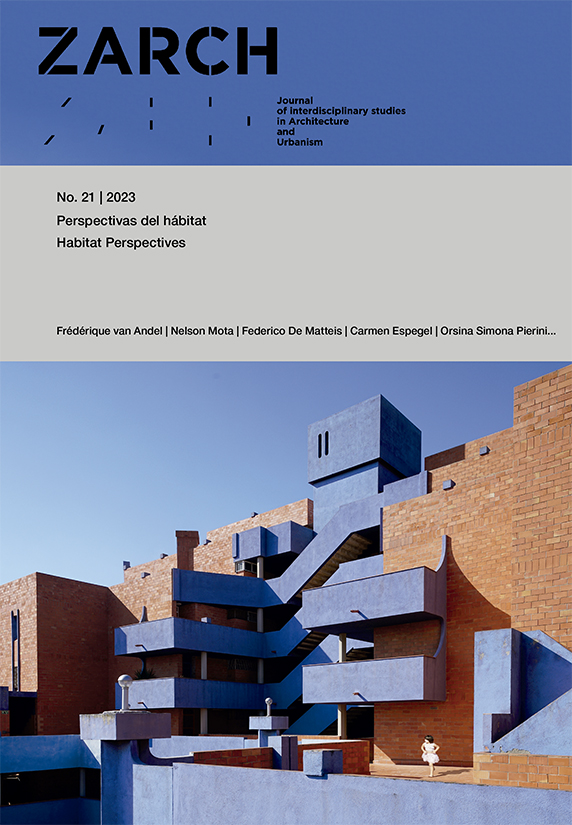Multiculturalism, Gender and Age: Three Challenges for the New European Collective Housing
DOI:
https://doi.org/10.26754/ojs_zarch/zarch.2023218884Keywords:
Collective Housing, Cultural Studies, Gender Perspective, Multiculturalism, AgeAbstract
Starting from the denunciation that "cultural studies" have made of the way housing has been produced in recent years, this article reflects on three challenges for the contemporary European collective housing project. Firstly, it analyses how collective housing must respond to the growing multiculturalism of our society; then it addresses the question of gender perspective in housing architecture; and finally, it takes age as a determining factor in the design of new housing. The aim is to discuss some of the opportunities and limitations that arise when approaching the housing project from these three perspectives. As part of that reflection, this article analyses five contemporary projects that address these issues. It concludes that new formulas are still required to respond to the challenges that multiculturalism, gender and age pose to European residential architecture.
Downloads
References
Cieraad, Irene. The family living room: a child playpen?, Home Cultures: The Journal of Architecture, Design and Domestic Space 10:3 (2013): 287-314.
Demirkan, Halime. Housing for the aging population. European Review of Aging and Physical Activity 4:1 (febrero 2007): 33–38. https://doi.org/10.1007/s11556-007-0016-z
Eurostat, Migration and migrant population statistics. European Comission, https://ec.europa.eu/eurostat/statistics-explained/index.php?title=Migration_and_migrant_population_statistics&stable=1#Migrant_population:_23.8_million_non-EU_citizens_living_in_the_EU_on_1_January_2022 (consultado el 10 de agosto de 2023).
Eurostat, Population Structure and Ageing. European Comission, https://ec.europa.eu/eurostat/statistics-explained/index.php?title=Population_structure_and_ageing (consultado el 10 de agosto de 2023).
Franck, Karen A. Exorcising the Ghost of Physical Determinism. Environment and Behaviour 16(4) (1984) 411–435. https://doi.org/10.1177/0013916584164001
García Vázquez, Carlos. La obsolescencia de las tipologías de vivienda de los polígonos residenciales construidos entre 1950 y 1976: Desajustes con la realidad sociocultural contemporánea. Informes de La Construcción 67: Extra-1 (2015) https://doi.org/10.3989/ic.14.045
Iltus, Sevket. Parental ideologies in the home safety management of one-to-four-year-old children. Tesis doctoral. The Graduate School and University Center of the City University of New York, 1994.
Jameson, Fredric. Teoría de la postmodernidad. Madrid: Editorial Trotta, 1996.
Krawitz, David; Friedman, Avi. Peeking through the keyhole: the evolution of North American homes. Ithaca: McGill-Queen’s University Press, 2002.
Imrie, Rob. Independent lives and the relevance of lifetime homes. Disability and Society 21:4 (Agosto 2006): 359–374. https://doi.org/10.1080/09687590600680152
Meah, Angela; Jackson, Peter. Crowded kitchens: the “democratisation” of domesticity? Gender, Place & Culture 20:5 (2013): 578–596. https://doi.org/10.1080/0966369X.2012.701202
Mota, Nelson. Alvaro Siza’s Negotiated Code: Housing with Citizens’ Participation in the Urban Renewal of the Hague in the 1980s. Urban Planning 4:3 (2019): 259. https://doi.org/10.17645/up.v4i3.2120
Paricio Ansuátegui, Ignacio; Sust i Fatjó, Xavier. La vivienda contemporánea: programa y tecnología. Barcelona: Institut de Tecnologia de la Construcció de Catalunya, 1998.
Peatross, Frieda Dell; Hasell, Mary Joyce. Changing lives/changing spaces: an investigation of the relationships between gender orientation and behaviours, and spatial preferences in residential kitchens. Journal of Architectural and Planning Research 9:3 (otoño 1992): 239-257.
Penoyre, Greg; Prasad, Sunand. Accommodating diversity. Housing design in a multicultural society. Londres: National Housing Federation, 1998.
Rock, Cynthia; Torre, Susana; Wright Gwendolyn. The appropriation of the house: Changes in house design and concepts of domesticity. En New space for women, coords. Gerda. R. Wekerle, Rebecca Peterson; David Morley, 83–100. Nueva York: Westview Press Boulder, 1982.
Siefert, Rebecca. The Women of Chicago Public Housing. Architects of their Own ‘Homeplace’. ZARCH 18 (junio 2022): 198-209. https://doi.org/10.26754/ojs_zarch/zarch.2022185884
Sykes, J. T. Living Independently with Neighbours Who Care: Strategies to Facilitate Aging in Place. En Design for Aging: A Comprehensive Package. Washington DC: American Institute of Architects/Association of Collegiate Schools of Architecture, 1992.
Downloads
Published
How to Cite
Issue
Section
Funding data
-
Universidad de Sevilla
Grant numbers V Plan Propio de Investigación





